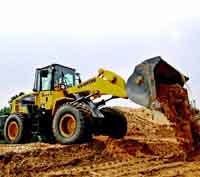Fluid power is a prime-time player in Komatsu's newest generation of mobile equipment.
Fig. 1. In Komatsu's hydrostatic transmission, an engine-driven variable-displacement piston pump provides flow to two variable-displacement piston motors.
For years, some car enthusiasts have anticipated the coming of the continuously variable transmission, and its related fuel savings. But for those who operate mobile machinery, the future is already here — and then some. The newest generation of mobile equipment has made great strides in incorporating hydrostatic transmissions (HSTs) into their drive systems, greatly increasing these machines' efficiencies.
Komatsu America Corp. has been focusing on HSTs on its wheel loaders since the first system debuted in May 2003. The hydrostatic transmission provides the loaders more digging power, quicker travel response, less operator effort, and greater fuel economy and machine efficiency.
HSTs are used instead of a wheel loader's conventional countershaft transmission. This hydrostatic transmission consists of an enginedriven variable-displacement pump, Figure 1, providing flow to two variable-displacement motors. The motors drive a geared drop-box, which distributes power to the front and rear axles. The operator is always in control of ground speed through the use of a foot throttle. The throttle controls engine speed, which drives the piston pump. When the operator pushes on the throttle, the pump supplies more flow to the motors and the loader travels faster. When the operator eases up on the throttle, flow decreases — and the loader travel speed will slow down through dynamic braking. In dynamic braking, if the pump isn't supplying flow to the motors, the motors won't turn, which means the axles won't turn either. Dynamic braking allows the operator to slow the loader without touching the service brakes.
More productive
A loader with HST operates as if it had an automatic geared transmission — but there are no gears, shifting, or clutch packs engaging. The HST drive train is more productive and more versatile and provides very quick response at any speed, aggressive tractive effort driving into a pile, and excellent climbing ability on a slope or a pile. This is because the operator is in full-time control of ground speed by using the accelerator pedal.
The operator sets the maximum rate of travel by setting the transmission speed dial and can then use the throttle to vary speed from 0 mph up to the maximum. There is no shift shock between gears or speed clutch packs. An operator-selected traction control feature allows controlling wheel spin by reducing tractive effort at the wheels.
To speed up v-cycles (the time it takes to raise the bucket into position over a truck bed) and make the operator more efficient, a variable-speed switch allows the operator to dial in the ground speed to match equipment hydraulic speed. By matching the two speeds, an operator can roll into dump position on a truck, dump, and pull out in reverse without using the brakes. When the transmission speed range dial is in position 1, the operator can — using the variable shift control dial — infinitely vary the maximum ground speed from the first speed to the maximum of the second speed. This allows the operator to dial in their ground travel time to match the time needed to raise the bucket to the desired dump position.
Controllability a key
When the brakes are needed, the two brake pedals feature inching capability. The first bit of travel of either the left or right brake pedals (they are interconnected and function together) reduces flow from the pump, slowing the loader down. Further depression of the pedal activates the service brakes. The service brakes now feature two wet discs per wheel, rather than one per wheel on previous models. The inching capability of the brake pedals allows the operator to slow the machine's movement toward a truck in a loading operation while keeping his engine speed high — to power the hydraulics in raising the bucket into the proper dump position. This feature accomplishes the same function as the transmission disconnect pedal on other loaders.
Many of the HST loaders feature joystick hydraulic controls. Atop the joystick is a toggle switch that controls directional shifts. The operator's hands never have to leave the steering wheel and joystick. The operator can change the direction (forward or reverse) of the loader with the flick of a thumb. If the operator is more comfortable using the old style directional shift lever on the steering column, it is still there.
If the operator times it properly, he or she will be able to ease up on the throttle as the loader nears the truck and let dynamic braking slow the tractor down. Then he or she can dump, use their thumb to flick into reverse, and pull back into another loading cycle without ever touching the brakes. This makes it easier on operators, makes them more efficient, and makes the brakes live longer.
HST tractors are equipped with a traction control system. The traction control system is controlled by a toggle switch near the transmission speed range control dial. When the traction control switch is in the on position, flow to the motors is reduced. This has the effect of reducing the available torque to the wheels and can be used to control wheel spin in certain conditions such as when operating on slippery concrete or deep sand.
Bob Post is a product manager for Komatsu America Corp., Vernon Hills, Ill. Contact him at bpost@ komatsuna.com or visit www. komatsuamerica.com for more details.



